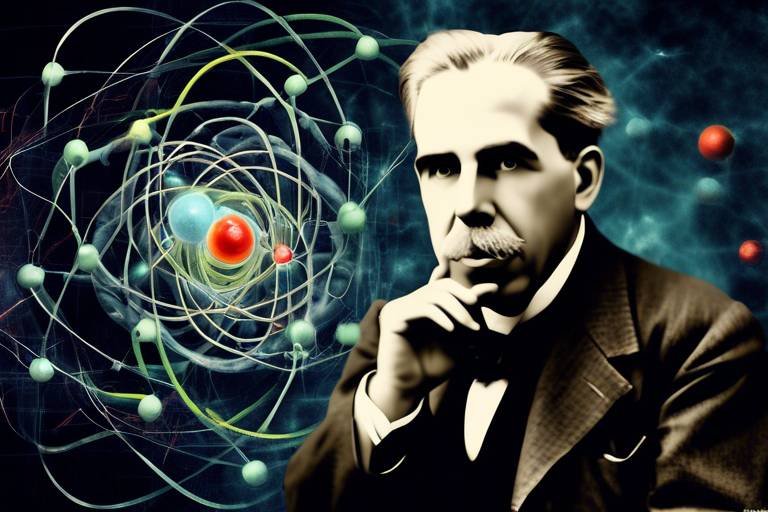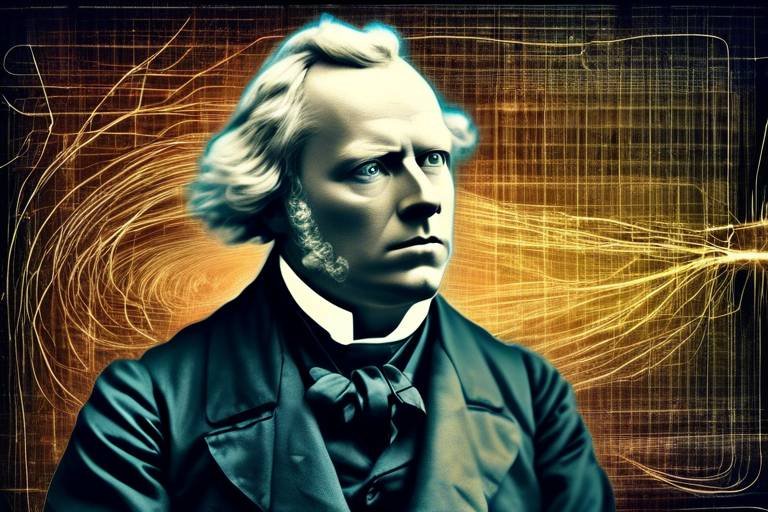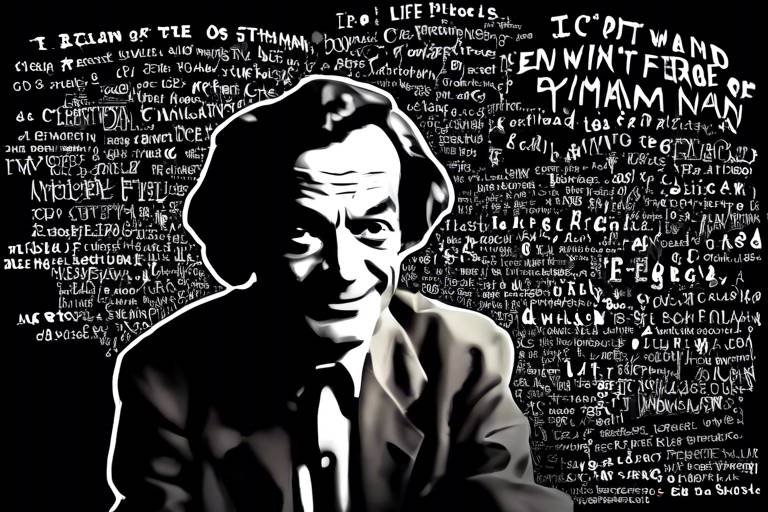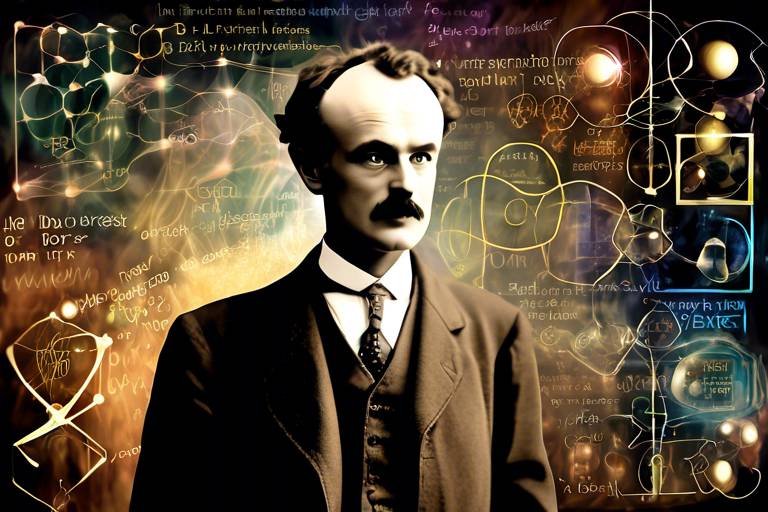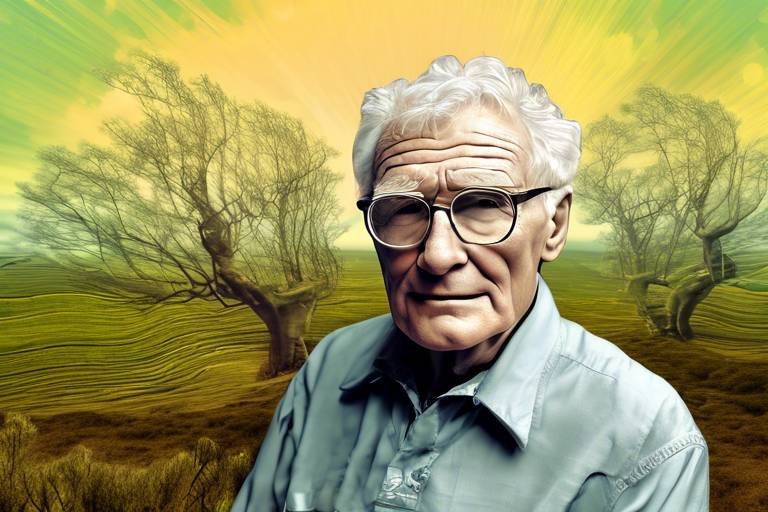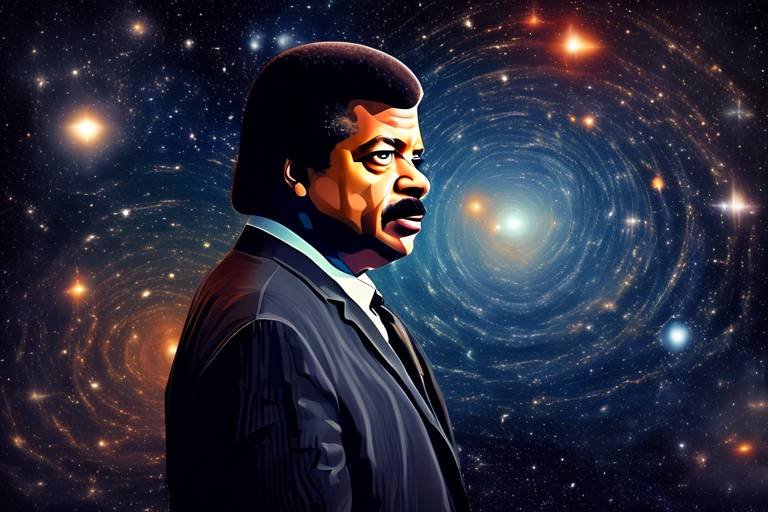The Contributions of Stephen Jay Gould to Evolutionary Theory
Stephen Jay Gould was not just a name in the field of evolutionary biology; he was a revolutionary thinker whose ideas reshaped the very foundation of how we understand evolution. His work has left an indelible mark on the scientific community, pushing boundaries and challenging long-held beliefs. Gould's contributions extend beyond mere theories; they encompass a way of thinking about evolution that embraces complexity, chance, and the intricacies of life itself. Have you ever wondered how species evolve in bursts rather than a steady, gradual process? Or why certain traits exist that seem to serve no apparent function? These questions lie at the heart of Gould's revolutionary ideas.
One of Gould's most significant contributions is his theory of punctuated equilibrium, which he co-developed with Niles Eldredge. This theory posits that species evolution is characterized by long periods of stability interrupted by brief episodes of rapid change. Imagine a calm sea suddenly disturbed by a storm; this analogy captures the essence of punctuated equilibrium. It challenges the traditional view of gradual evolution, suggesting that the fossil record is not just a slow, steady accumulation of changes but rather a series of dynamic events that can reshape entire species in a relatively short time.
Gould's critiques of adaptationism further illustrate his profound impact on evolutionary theory. Adaptationism—the idea that all traits are the result of natural selection—was a dominant paradigm before Gould's intervention. He argued that not every trait has to be adaptive; some may be byproducts of evolutionary history or the result of random chance. This perspective opened up new avenues for understanding how and why certain characteristics persist in populations. By shifting the focus from a narrow view of adaptation to a broader understanding that includes historical contingencies, Gould invited scientists to explore the complexities of evolution in a more nuanced way.
Moreover, Gould's influence extends to paleontology, where his insights into the fossil record have enriched our understanding of evolutionary history. He emphasized the importance of fossils not merely as remnants of the past but as critical pieces of the puzzle that reveal how life has evolved over millions of years. His work highlighted the dynamic relationship between paleontology and evolutionary processes, demonstrating that fossils can tell us much more than just what organisms looked like—they can reveal the very patterns of evolution itself.
Gould was also a master at popularizing complex scientific ideas, making them accessible to the general public. Through his writings and lectures, he engaged a broader audience in discussions about evolution, sparking interest and curiosity. His ability to communicate intricate concepts in an engaging and understandable manner has inspired countless individuals to delve deeper into the mysteries of life and evolution.
In summary, the contributions of Stephen Jay Gould to evolutionary theory are vast and varied. From his groundbreaking theory of punctuated equilibrium to his critiques of adaptationism and his insights into paleontology, Gould has profoundly influenced how we think about evolution. His legacy is not just in the theories he proposed but in the way he challenged us to think critically and embrace the complexities of life. So, the next time you ponder the wonders of evolution, remember the name Stephen Jay Gould—a true pioneer who changed the way we view the natural world.
- What is punctuated equilibrium?
Punctuated equilibrium is a theory that suggests species evolution occurs in rapid bursts, followed by long periods of stability.
- How did Gould critique adaptationism?
Gould argued that not all traits are adaptive; some may arise from historical contingencies or random chance.
- Why are fossils important in evolutionary theory?
Fossils provide essential evidence of evolutionary history and help us understand the processes that shape species over time.
- How did Gould popularize evolutionary ideas?
Through his engaging writings and lectures, Gould made complex scientific concepts accessible to the general public.

Gould's Theory of Punctuated Equilibrium
The theory of punctuated equilibrium, co-developed by Stephen Jay Gould and Niles Eldredge in the early 1970s, serves as a revolutionary concept in the realm of evolutionary biology. This theory fundamentally challenges the long-standing view that evolution occurs uniformly and gradually over time, a perspective often referred to as phyletic gradualism. Instead, punctuated equilibrium posits that species remain relatively stable for long periods, interrupted by brief, significant changes during which new species emerge rapidly. Imagine a calm lake, where the surface remains undisturbed for ages, only to be interrupted by sudden, powerful storms that reshape the landscape. This analogy captures the essence of Gould’s theory, illustrating how evolutionary change can be both gradual and explosive.
One of the key implications of punctuated equilibrium is its impact on our understanding of the fossil record. Traditionally, paleontologists expected to find a continuous, gradual transition between species in the fossil layers. However, Gould and Eldredge argued that this expectation was misguided. They pointed out that the fossil record often shows long periods of stability, or stasis, followed by sudden appearances of new species. This observation led to a paradigm shift in how scientists interpret fossils. Rather than viewing the fossil record as a smooth continuum, it is now recognized as a patchwork of abrupt changes, which raises intriguing questions about the mechanisms driving these rapid transformations.
Gould's theory also emphasizes the role of geographical isolation in species evolution. When populations become isolated due to environmental changes, such as geological events or climate shifts, they are more likely to diverge rapidly from their ancestral forms. This concept aligns with the idea of adaptive radiation, where species rapidly evolve to fill different ecological niches. In this context, Gould’s theory provides a framework for understanding how new species can emerge in response to changing environments, much like how a single spark can ignite a fire, leading to an explosion of new growth.
Furthermore, punctuated equilibrium has significant implications for the study of biodiversity. It challenges scientists to reconsider how they view the processes that contribute to the rich tapestry of life on Earth. Instead of assuming that every trait or characteristic has developed through a slow, adaptive process, Gould’s perspective invites researchers to consider the role of chance events and historical contingencies. This approach opens up new avenues of exploration, allowing for a more nuanced understanding of evolution that encompasses both the gradual and the sudden.
In summary, Gould's theory of punctuated equilibrium not only reshaped the way we understand the evolutionary process but also highlighted the complexities inherent in the fossil record. By advocating for a model that incorporates both stability and rapid change, Gould provided a fresh lens through which to examine the history of life on our planet. It’s a reminder that evolution is not just a slow march forward; it can also be a series of dramatic leaps that redefine the very fabric of biodiversity.

Critique of Adaptationism
When we think about evolution, it’s easy to fall into the trap of viewing every single trait as a result of natural selection. This idea, known as adaptationism, suggests that all characteristics of organisms are optimally designed for their environments. However, Stephen Jay Gould challenged this notion, arguing that not every trait is a product of adaptive evolution. Instead, he posited that many traits could arise from historical contingencies or even random events, which can significantly shape the evolutionary path of a species.
Gould's critique of adaptationism was not just a minor disagreement; it was a fundamental challenge to a prevailing paradigm in evolutionary biology. He believed that the emphasis on adaptation led to a narrow understanding of evolution, one that overlooked the complexity of biological history. For Gould, evolution is not just a straightforward path of progress but a meandering journey influenced by a myriad of factors, including chance and environmental changes.
One of the key points Gould made was that adaptationism often ignores the role of stochastic events—random occurrences that can have significant impacts on evolutionary trajectories. To illustrate this, consider a scenario where a species faces a sudden environmental shift, such as a volcanic eruption or climate change. In such cases, traits that may have once been advantageous could become maladaptive overnight, while others that were previously irrelevant might suddenly become crucial for survival. This unpredictability underscores the importance of considering factors beyond just adaptation.
Moreover, Gould argued that adaptationism tends to oversimplify the relationship between traits and their functions. He suggested that many traits can be byproducts of other evolutionary changes rather than direct adaptations. For example, the large size of a peacock's tail is often cited as an adaptive trait for attracting mates. However, Gould would argue that this beautiful display may also be a byproduct of other evolutionary pressures, such as sexual selection, rather than a direct response to environmental challenges.
In his work, Gould often highlighted the importance of historical context in understanding evolutionary processes. He believed that the history of life is filled with unique events that shape the traits of organisms in unexpected ways. This perspective encourages scientists to look beyond the immediate adaptive significance of traits and consider how historical events have influenced their development. For instance, the presence of certain traits in a species may be more about the evolutionary history of that lineage than about current adaptive needs.
Gould's critiques have had a profound impact on the field of evolutionary biology. They have pushed researchers to broaden their thinking and consider non-adaptive explanations for traits. This shift has led to a more nuanced understanding of evolution, one that recognizes the complexity of biological systems and the interplay of various factors in shaping life on Earth.
In summary, Gould's critique of adaptationism reshaped the landscape of evolutionary biology. His emphasis on historical contingencies and the role of chance events encourages a more holistic view of evolution, reminding us that life is not just about survival of the fittest but also about the unpredictable twists and turns of history.
- What is adaptationism? Adaptationism is the idea that all traits of organisms are optimized for their environments through natural selection.
- How did Gould challenge adaptationism? Gould argued that many traits are not adaptive and can arise from historical contingencies or random events.
- What are historical contingencies? These are past events that influence the evolutionary trajectory of a species, often in unpredictable ways.
- Why is it important to consider non-adaptive explanations? Considering non-adaptive explanations leads to a more comprehensive understanding of evolution and the complexity of biological systems.

Historical Context of Adaptationism
To truly grasp Stephen Jay Gould's critique of adaptationism, it’s essential to take a step back and explore the historical context that paved the way for this dominant paradigm in evolutionary biology. Adaptationism emerged prominently in the mid-20th century, largely influenced by the modern synthesis of evolutionary theory, which seamlessly integrated Mendelian genetics with Darwinian natural selection. This synthesis painted a picture where evolutionary change was primarily driven by the adaptation of organisms to their environments, suggesting that most traits evolved because they provided some form of adaptive advantage.
During this period, many biologists began to view adaptation as the central mechanism of evolution, leading to the assumption that every trait must serve a clear purpose in the context of survival and reproduction. This perspective was so pervasive that it overshadowed alternative explanations for the presence of certain traits. For instance, traits that seemed maladaptive or neutral were often dismissed or overlooked. The prevailing thought was that natural selection was a relentless force, sculpting organisms into perfectly adapted beings, akin to an artist refining a sculpture until it achieves perfection.
However, Gould, along with his colleague Niles Eldredge, began to challenge this notion through their theory of punctuated equilibrium, which suggested that species experience long periods of stability interrupted by brief episodes of rapid change. This perspective implied that not all evolutionary changes are driven by adaptive pressures; instead, chance events and historical contingencies play a crucial role. To illustrate this point, let’s consider the following table that contrasts adaptationism with Gould's views:
| Aspect | Adaptationism | Gould's Perspective |
|---|---|---|
| Driving Force of Evolution | Natural Selection | Historical Contingencies & Chance Events |
| View on Traits | All traits are adaptive | Some traits may be non-adaptive or neutral |
| Evolutionary Change | Gradual and continuous | Punctuated by rapid changes |
This shift in thinking was not merely an academic exercise; it had profound implications for how we understand the complexity of life on Earth. Gould’s critique urged scientists to look beyond the simplistic view that every feature of an organism is the result of natural selection. Instead, he encouraged a more nuanced approach, where the historical context and the randomness of evolutionary processes are acknowledged. This perspective has led to a richer understanding of evolutionary biology, opening the door for discussions on how chance and contingency can shape the evolutionary narrative.
In summary, the historical context of adaptationism is crucial for understanding the significance of Gould's contributions. By challenging the established norms of his time, he not only reshaped the discourse within evolutionary biology but also encouraged future generations to think critically about the mechanisms that drive evolution. As we continue to explore the intricacies of life’s history, Gould's insights remain a vital part of the conversation, reminding us that evolution is a complex tapestry woven from both adaptive and non-adaptive threads.
- What is adaptationism? Adaptationism is the view that most traits of organisms are adaptations that have evolved through natural selection to serve specific functions.
- Who is Stephen Jay Gould? Stephen Jay Gould was an influential American paleontologist, evolutionary biologist, and historian of science, known for his contributions to evolutionary theory and the popularization of science.
- What is punctuated equilibrium? Punctuated equilibrium is a theory co-developed by Gould and Eldredge, suggesting that species remain relatively unchanged for long periods, interrupted by brief episodes of rapid evolution.

Gould's Alternative Views
Stephen Jay Gould was not just a critic of established evolutionary thought; he was a beacon of alternative perspectives that reshaped how we understand evolution. One of his most compelling arguments revolved around the concept of historical contingency. This idea posits that the course of evolution is significantly influenced by random, chance events that occur over time. Think of it like a game of chance—one small roll of the dice can lead to completely different outcomes. In the grand tapestry of life, certain species may thrive or perish based on circumstances that seem trivial in hindsight.
Gould argued that evolution is not a linear progression toward perfection, as suggested by some traditional views. Instead, it resembles a complex, branching tree where the paths taken are often determined by random occurrences. For instance, if a meteor had not struck Earth 66 million years ago, wiping out the dinosaurs, mammals might never have had the opportunity to diversify and evolve into the dominant species we see today. This perspective challenges the notion that all evolutionary traits are the result of direct adaptations to the environment.
Furthermore, Gould emphasized the importance of non-adaptive traits—features that arise not because they provide a survival advantage, but due to historical accidents or constraints. For example, the human appendix is often cited as a non-adaptive trait; while it may have had a purpose in our ancestors, it now serves little function. Gould's insights urged scientists to consider a broader range of factors when examining evolutionary processes, moving beyond the simplistic view that every trait must serve a clear adaptive purpose.
In his work, Gould also highlighted the concept of exaptation, where a trait originally evolved for one purpose becomes advantageous for another. For instance, feathers initially evolved for insulation but later played a crucial role in the evolution of flight. This idea underscores the complexity of evolutionary pathways and how traits can be repurposed over time, further complicating the narrative of straightforward adaptation.
To sum up, Gould's alternative views not only provided a fresh lens through which to examine evolutionary biology but also opened the door for a more nuanced understanding of how life on Earth has developed. His insistence on the role of chance, historical accidents, and the multifaceted nature of traits has left an indelible mark on the field, encouraging future generations of biologists to think critically about the processes that shape the living world.
- What is punctuated equilibrium?
Punctuated equilibrium is a theory co-developed by Gould that suggests species evolve in rapid bursts followed by long periods of stability, challenging the traditional view of gradual evolution.
- What is adaptationism?
Adaptationism is the belief that most traits of organisms are adaptations that have evolved to serve specific functions. Gould critiqued this view, arguing that not all traits are adaptive.
- How did Gould influence modern evolutionary biology?
Gould's critiques and alternative views have encouraged researchers to explore non-adaptive explanations for traits and consider the role of historical contingencies in evolution.

Impact on Modern Evolutionary Biology
Stephen Jay Gould's influence on modern evolutionary biology is nothing short of revolutionary. His ideas have reshaped how scientists approach the study of evolution, pushing the boundaries of traditional thought and encouraging a broader view of evolutionary processes. One of the most significant aspects of Gould's legacy is his challenge to the dominant narrative of adaptationism, which posits that all evolutionary traits are the result of natural selection acting to optimize organisms for their environments. By questioning this paradigm, Gould opened the door to a multitude of non-adaptive explanations for the diversity of life on Earth.
For instance, his concept of punctuated equilibrium introduced the idea that evolution does not always proceed at a steady, gradual pace. Instead, it can occur in bursts of rapid change followed by long periods of stability. This perspective has profound implications for how we interpret the fossil record and understand the history of life. It suggests that the evolutionary process is more dynamic and unpredictable than previously thought, emphasizing the role of chance events and historical contingencies in shaping the path of evolution.
Moreover, Gould's critiques have encouraged modern evolutionary biologists to consider alternative mechanisms of evolution, such as genetic drift and developmental constraints. These ideas have led to a richer understanding of how various factors can influence evolutionary trajectories. For example, researchers are now more likely to explore how random events can lead to significant evolutionary changes, which was often overlooked in traditional adaptationist frameworks.
As a result, Gould's contributions have not only sparked new lines of inquiry but have also fostered a more inclusive and diverse scientific discourse. His work has inspired a generation of evolutionary biologists to embrace complexity and acknowledge the multifaceted nature of evolutionary processes. This shift is evident in contemporary research, where scientists are increasingly integrating insights from genetics, paleontology, and ecology to form a holistic view of evolution.
To illustrate the lasting impact of Gould's ideas, consider the following table that summarizes key shifts in evolutionary thought influenced by his work:
| Traditional View | Gould's Perspective |
|---|---|
| Gradualism as the primary mode of evolution | Punctuated equilibrium highlights bursts of rapid change |
| All traits are adaptive | Not all traits are necessarily adaptive; chance plays a role |
| Focus on natural selection as the sole mechanism | Incorporation of genetic drift and historical contingencies |
| Linear progression of species | Complex branching and reticulation of evolutionary paths |
In conclusion, the impact of Stephen Jay Gould on modern evolutionary biology is profound and enduring. His work has encouraged scientists to think critically about evolutionary mechanisms and to recognize the complexity of life's history. As we continue to explore the depths of evolutionary theory, Gould's insights will undoubtedly remain a guiding light, inspiring future generations of researchers to question, explore, and expand our understanding of evolution.
- What is punctuated equilibrium?
Punctuated equilibrium is a theory co-developed by Stephen Jay Gould that suggests evolution occurs in rapid bursts followed by long periods of stability, challenging the traditional view of gradual evolution. - How did Gould critique adaptationism?
Gould argued that not all traits are adaptive and emphasized the importance of historical contingencies and chance events in shaping evolutionary outcomes. - What is the significance of Gould's work in paleontology?
Gould's contributions to paleontology helped bridge the gap between fossil records and evolutionary theory, highlighting the importance of fossils in understanding evolutionary history.

Collaboration with Niles Eldredge
Stephen Jay Gould's collaboration with Niles Eldredge was nothing short of revolutionary in the field of evolutionary biology. Together, they introduced the groundbreaking concept of punctuated equilibrium, which fundamentally altered the way scientists understand the process of evolution. This theory posits that species remain relatively stable for long periods, punctuated by brief, rapid changes during which new species emerge. This idea was a stark contrast to the traditional view of gradual evolution, and it opened up a whole new avenue of research and discussion.
Gould and Eldredge first articulated their theory in a joint paper published in 1972, which sparked considerable debate and interest within the scientific community. Their collaboration was characterized by a strong intellectual synergy, as both scholars brought their unique perspectives and expertise to the table. Gould, known for his eloquent writing and ability to communicate complex ideas, complemented Eldredge's expertise in paleontology. Together, they provided a comprehensive framework that allowed for a better understanding of the fossil record and the dynamics of speciation.
Their partnership was not just limited to the theoretical aspects; they also engaged in extensive fieldwork, studying fossils and gathering data to support their claims. This hands-on approach helped to solidify their arguments and provided tangible evidence for the punctuated equilibrium model. The duo's work emphasized the importance of historical contingencies and environmental factors that contribute to evolutionary changes, challenging the notion that evolution is a linear process.
It's fascinating to note how their collaboration influenced not only their own research but also the broader scientific discourse. The introduction of punctuated equilibrium prompted a reevaluation of existing theories and encouraged scientists to explore alternative explanations for evolutionary phenomena. As a result, Gould and Eldredge's work has left a lasting legacy, inspiring generations of researchers to think critically about the complexities of evolution.
In summary, the collaboration between Gould and Eldredge was a pivotal moment in the history of evolutionary biology. Their joint efforts not only reshaped the understanding of how species evolve but also highlighted the value of interdisciplinary collaboration in scientific research. By combining their strengths, they were able to push the boundaries of evolutionary theory and encourage a more nuanced view of the natural world.
- What is punctuated equilibrium? Punctuated equilibrium is a theory in evolutionary biology that suggests species remain stable for long periods, with rapid changes occurring during brief intervals.
- Who were Stephen Jay Gould and Niles Eldredge? They were prominent paleontologists and evolutionary biologists who collaborated to develop the theory of punctuated equilibrium.
- How did their collaboration impact evolutionary biology? Their partnership led to a significant shift in understanding species evolution, encouraging scientists to explore alternative explanations beyond gradualism.
- What are historical contingencies in evolution? Historical contingencies refer to the idea that random events and specific historical circumstances can significantly influence evolutionary outcomes.

Gould's Contributions to Paleontology
Stephen Jay Gould was not just a prominent figure in evolutionary theory; he also made significant contributions to the field of paleontology. His work helped bridge the gap between theoretical biology and the fossil record, providing a deeper understanding of how life has evolved over millions of years. Gould's insights into the fossil record transformed how scientists interpret the evidence of life’s history, highlighting the importance of both the organisms themselves and the environmental contexts in which they lived.
One of Gould's major contributions was his emphasis on the role of fossils in understanding evolutionary processes. He argued that the fossil record is not merely a collection of bones and shells but a rich narrative that reveals the complexities of evolution. Through his research, he demonstrated that fossils can tell us about the diversity of life forms that existed at different times, as well as the environmental changes that influenced their development. This perspective was groundbreaking because it shifted the focus from merely cataloging fossils to interpreting their significance in the broader context of evolutionary history.
Gould's work also brought attention to the concept of historical contingency. He believed that the paths of evolution are often shaped by random events and unique circumstances rather than solely by adaptive pressures. For instance, he argued that the extinction of the dinosaurs created opportunities for mammals to flourish, leading to the diverse array of species we see today. This idea underscores the unpredictability of evolution and challenges the notion that it follows a linear, predetermined path. By highlighting these contingencies, Gould opened up new avenues for research and debate within the field of paleontology.
In addition to his theoretical contributions, Gould was a passionate advocate for the public understanding of science. He wrote extensively for a general audience, making complex ideas accessible and engaging. His essays in Natural History magazine and his books, such as Wonderful Life and The Mismeasure of Man, not only popularized evolutionary concepts but also emphasized the importance of paleontological evidence in understanding evolution. Through his storytelling ability, he captivated readers and encouraged them to think critically about the natural world.
Moreover, Gould's collaborative work with other paleontologists further enriched the field. His partnership with Niles Eldredge was particularly noteworthy. Together, they developed the theory of punctuated equilibrium, which posits that evolutionary change occurs in rapid bursts, followed by long periods of stability. This theory has profound implications for how we interpret the fossil record, suggesting that the absence of transitional forms does not necessarily indicate a lack of evolution but may reflect the nature of the evolutionary process itself.
In summary, Stephen Jay Gould's contributions to paleontology were multifaceted and transformative. He not only advanced theoretical frameworks but also engaged the public in meaningful discussions about evolution and its implications. His legacy continues to inspire paleontologists and evolutionary biologists alike, reminding us that the study of life’s history is as much about the stories fossils tell as it is about the organisms themselves.
- What is punctuated equilibrium? Punctuated equilibrium is a theory developed by Gould and Eldredge that suggests that species experience long periods of stability interrupted by brief episodes of rapid change.
- How did Gould's work influence modern paleontology? Gould's emphasis on historical contingency and the interpretation of the fossil record has led to a more nuanced understanding of evolution, encouraging researchers to consider non-linear evolutionary paths.
- Why is the fossil record important in evolutionary biology? The fossil record provides crucial evidence of how life has changed over time, revealing the diversity of organisms and the environmental factors that influenced their evolution.

The Role of Fossils in Evolutionary Theory
Fossils are like the time capsules of our planet, offering a glimpse into the distant past and the evolutionary journey of life. They provide invaluable evidence that helps scientists piece together the complex puzzle of how species have evolved over millions of years. Stephen Jay Gould emphasized the significance of fossils in understanding evolutionary processes, arguing that they are not just remnants of past organisms but also crucial data points that inform our theories about evolution.
One of the most fascinating aspects of fossils is their ability to show transitional forms—organisms that exhibit traits common to both ancestral and descendant groups. These transitional fossils serve as a bridge in the evolutionary narrative, demonstrating how species adapt and change over time. For example, the famous Archaeopteryx fossil showcases features of both dinosaurs and modern birds, providing a clear illustration of how flight might have evolved.
Gould argued that the fossil record is not merely a collection of bones but a dynamic archive that reveals the history of life on Earth. He pointed out that while some may view the fossil record as incomplete, it still offers crucial insights into evolutionary patterns. For instance, the concept of punctuated equilibrium that Gould co-developed suggests that evolution does not always proceed at a slow and steady pace. Instead, it can occur in bursts, often coinciding with significant environmental changes or catastrophic events. This theory reshapes our understanding of how quickly species can arise and adapt in response to new challenges.
Moreover, Gould highlighted the importance of studying the distribution of fossils across different geological layers. By examining which species appear in which strata, scientists can infer the relative ages of different organisms and understand the timing of evolutionary events. This stratigraphic approach is essential for constructing a coherent timeline of life on Earth. For example, the appearance of certain mammal fossils in the Cenozoic era marks a significant shift in biodiversity following the extinction of the dinosaurs, showcasing how life can rebound and diversify after mass extinctions.
In addition to providing evidence for evolutionary change, fossils also help scientists understand the ecological contexts in which ancient organisms lived. By analyzing fossilized remains, researchers can reconstruct ancient environments and ecosystems, offering insights into how species interacted with one another and their surroundings. This ecological perspective is vital for grasping the complexities of evolution, as it illustrates that organisms do not evolve in isolation but rather in response to their biotic and abiotic environments.
In summary, fossils play a pivotal role in evolutionary theory by serving as both evidence and context for understanding the history of life. Gould's work has not only highlighted their importance but has also encouraged further exploration into how these ancient remnants can inform our understanding of evolution. As we continue to unearth new fossils, we unlock more secrets about our planet's biological history, allowing us to appreciate the intricate tapestry of life that has unfolded over billions of years.
- What are fossils? Fossils are preserved remains or traces of ancient organisms that provide evidence of past life on Earth.
- Why are fossils important for evolutionary theory? Fossils help scientists understand the history of life, showing transitional forms and the timing of evolutionary changes.
- What is punctuated equilibrium? It is a theory that suggests evolution occurs in rapid bursts, followed by long periods of stability, challenging the idea of gradual evolution.

Popularization of Evolutionary Ideas
Stephen Jay Gould was not just a brilliant evolutionary biologist; he was also a master communicator. His ability to translate complex scientific concepts into engaging narratives made evolutionary ideas accessible to the general public. Imagine trying to explain the intricacies of evolution to someone who has never studied biology—Gould did just that, and he did it with flair. Through his numerous writings, lectures, and public appearances, he brought the wonders of evolutionary theory into the everyday conversation.
One of the most remarkable aspects of Gould's approach was his knack for storytelling. He often used anecdotes and historical examples to illustrate key points, making the science relatable. For instance, in his book "Wonderful Life," he explored the Burgess Shale fossils, using them as a lens to discuss the unpredictability of evolution. This narrative not only captivated readers but also challenged the notion of a linear evolutionary path. By highlighting the role of chance and contingency, he opened up new avenues for understanding life's complexity.
Gould's writings were not confined to academic journals; he ventured into popular science books and essays, reaching a broader audience. His monthly column in Natural History magazine, titled "This View of Life," became a staple for many who wanted to understand the nuances of evolutionary biology without needing a PhD. In these columns, he tackled a variety of topics, from the intricacies of the fossil record to the societal implications of evolutionary theory. This accessibility was crucial in demystifying science, allowing readers to engage with ideas that were once considered the domain of specialists.
Moreover, Gould's ability to provoke thought and discussion was evident in his debates with other prominent scientists. He wasn't afraid to challenge prevailing views, and this willingness to engage in dialogue made him a prominent figure in both the scientific community and the public sphere. His debates with figures like Richard Dawkins highlighted the diversity of thought within evolutionary biology, encouraging people to think critically about the science behind evolution.
To further illustrate his impact, here’s a table summarizing some of his most influential works and their contributions to popularizing evolutionary ideas:
| Book/Article | Year | Key Contribution |
|---|---|---|
| Ontogeny and Phylogeny | 1977 | Explored the relationship between development and evolution, emphasizing the importance of embryology. |
| Wonderful Life | 1989 | Introduced the concept of contingency in evolution, using the Burgess Shale fossils as a case study. |
| The Mismeasure of Man | 1981 | Critiqued the misuse of biological determinism and argued against the idea that intelligence is purely genetic. |
| This View of Life | 1974-2001 | His column that brought evolutionary concepts to the public, sparking interest and discussion. |
In addition to his written work, Gould's public lectures were instrumental in spreading evolutionary ideas. He had a unique ability to engage audiences, often using humor and thought-provoking questions to stimulate interest. His talks were not just lectures; they were performances that invited people to ponder the mysteries of life and evolution. By making science fun and approachable, he inspired countless individuals to explore the field further.
In conclusion, Stephen Jay Gould's contributions to the popularization of evolutionary ideas cannot be overstated. His ability to communicate complex concepts in an engaging and relatable manner has left a lasting legacy, ensuring that the wonders of evolution remain a topic of interest for both scientists and the general public alike. Through his storytelling, writings, and public engagements, he opened the door to a deeper understanding of our place in the natural world, making him not just a scientist, but a true ambassador of evolutionary thought.
- What is the main idea behind punctuated equilibrium?
Punctuated equilibrium suggests that evolution is characterized by long periods of stability interrupted by brief periods of rapid change, challenging the traditional view of gradual evolution.
- How did Gould critique adaptationism?
Gould argued that not all traits are adaptive and that historical contingencies play a significant role in shaping evolutionary outcomes.
- What role did Gould play in popularizing evolutionary biology?
Gould made evolutionary concepts accessible through his writings, public lectures, and debates, engaging a broader audience in discussions about evolution.
Frequently Asked Questions
- What is the theory of punctuated equilibrium?
Punctuated equilibrium is a theory co-developed by Stephen Jay Gould and Niles Eldredge, suggesting that species evolution occurs in rapid bursts of change followed by long periods of stability. This challenges the traditional view that evolution happens gradually and consistently over time.
- How did Gould critique adaptationism?
Gould argued that not all traits in organisms are necessarily adaptive. He believed that many features could arise from historical contingencies and random events, rather than solely through natural selection. This perspective opened the door for a broader understanding of evolutionary processes.
- What was the historical context of adaptationism before Gould?
Before Gould's critiques, adaptationism dominated evolutionary thought, suggesting that every trait had a specific adaptive purpose. This framework was widely accepted, but Gould's work prompted scientists to reconsider this view and explore alternative explanations for the diversity of life.
- What alternative views did Gould propose?
Gould emphasized the role of chance events and historical factors in shaping evolutionary outcomes. He argued that the evolutionary path of a species could be significantly influenced by random occurrences, which challenged the idea that evolution is a linear and predictable process.
- What impact did Gould have on modern evolutionary biology?
Gould's critiques and ideas have had a lasting impact on evolutionary biology, encouraging researchers to consider non-adaptive explanations for traits and behaviors. His work has fostered a more nuanced understanding of evolution, prompting ongoing discussions and research in the field.
- How did Gould collaborate with Niles Eldredge?
Gould and Eldredge worked together to develop the theory of punctuated equilibrium, contributing to the understanding of how species evolve. Their collaboration was significant in bringing attention to the importance of fossil records in illustrating evolutionary patterns.
- What contributions did Gould make to paleontology?
Gould made significant contributions to paleontology by providing insights into the fossil record and its implications for evolutionary history. He highlighted the importance of fossils in understanding evolutionary processes and the history of life on Earth.
- Why are fossils important in evolutionary theory?
Fossils serve as crucial evidence for evolutionary theory, offering a window into the past and helping scientists understand how species have changed over time. Gould emphasized their role in linking paleontology with evolutionary processes, showcasing how fossil evidence supports various evolutionary theories.
- How did Gould popularize evolutionary ideas?
Gould was instrumental in making complex evolutionary concepts accessible to the general public through his engaging writings and lectures. He had a talent for explaining scientific ideas in relatable terms, which helped spark interest and understanding of evolution among a broader audience.


